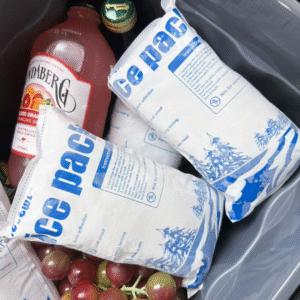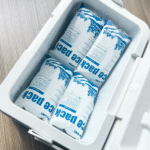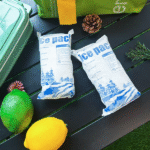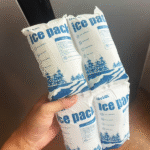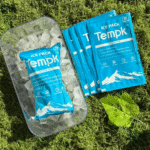Choosing the Best Dry Ice Packs & Supplier for Efficient Cold Chain Shipping in 2025
Beim Versandtemperaturempfindlichkeitsgüter, maintaining a consistent cold chain is critical. Dry ice packs are the most reliable solution for preserving frozen products during transit. Egal, ob Sie Lebensmittel versenden, Arzneimittel, oder andere verderbliche Waren, understanding how to choose the right dry ice supplier and the best type of dry ice pack can ensure safe and efficient delivery. In diesem Leitfaden, we’ll cover everything from types of dry ice packs to supplier selection, pricing considerations, and safety tips.
-
Understand the different types of dry ice packs and their applications.
-
Learn how to select the best dry ice supplier für Ihre Bedürfnisse.
-
Compare dry ice packs with other cooling solutions, like gel packs and PCM.
-
Discover how to safely handle, speichern, and ship with dry ice.
-
Stay ahead of market trends and regulatory changes in 2025.
H2: What Are Dry Ice Packs and Why Are They Essential?
Dry ice packs are solidified carbon dioxide (Co₂) that sublimate at ultra-low temperatures, making them perfect for shipping frozen items. Im Gegensatz zu traditionellem Eis, dry ice doesn’t leave any water residue, ensuring your products stay dry and properly cooled. This section breaks down the key reasons to use dry ice:
Benefits of Dry Ice Packs:
-
Ultra-Cold Cooling: Dry ice reaches temperatures as low as -78.5°C, ideal for products that require freezing.
-
No Water Residue: Im Gegensatz zu normalem Eis, dry ice sublimates into gas without leaving moisture behind, preventing water damage to goods.
-
Längere Kühldauer: Dry ice lasts much longer than ice, which helps reduce the risk of temperature excursions during long shipments.
H3: Wie funktionieren trockene Eisbeutel??
Trockeneis untermauert, turning directly from solid to gas without going through a liquid phase. This makes it ideal for shipping goods over long distances, where extended cooling is required. The sublimation process of dry ice ensures a constant supply of cold air without the mess of melting water. Dry ice works by absorbing heat from its surroundings, maintaining the required temperature for perishable goods, and ensuring their safety during transit.
| Type of Dry Ice | Kühldauer | Am besten für | Anwendungen |
|---|---|---|---|
| Dry Ice Blocks | 48-72 Std. | Fernversand | Pharmazeutika, large food shipments |
| Trockeneispellets | 24-48 Std. | Rapid cooling | Laboratories, medizinische Versorgung |
| Trockeneisblätter | 12-24 Std. | Small-scale, precise cooling | Perishable food packaging, Sensible Gegenstände |
H2: How to Choose the Right Dry Ice Supplier?
Schlüsselüberlegungen:
Selecting a reliable dry ice supplier is crucial to ensure that you get high-quality products and services that meet your shipping needs. Here are the key factors to keep in mind:
-
Produktqualität: Ensure the supplier offers food-grade dry ice that meets FDA standards, with CO₂ purity of at least 99.9%.
-
Variety of Packaging Options: Look for suppliers that offer a range of sizes and types, such as blocks, Pellets, or sheets, to match your specific needs.
-
Delivery and Shipping Capabilities: Choose a supplier that can provide timely delivery with insulated packaging to prevent sublimation during transport.
-
Customer Support and Compliance: A good supplier will help you navigate regulations, provide the necessary labels (Z.B., UN1845), and offer training if needed.
Top Dry Ice Suppliers to Consider:
-
Linde Gas – Global supplier with a range of dry ice products, reliable delivery, and quick shipping.
-
Airgas – Offers dry ice in blocks, Pellets, and sheets with fast delivery options.
-
CryoPort – Specializes in custom solutions for temperature-sensitive logistics, particularly for pharmaceuticals.
H2: How Much Do Dry Ice Packs Cost?
The price of dry ice packs can vary depending on the quantity, Größe, und Lage. Durchschnittlich, dry ice costs between $1 Und $3 pro Pfund. Jedoch, other factors, such as shipping fees and packaging, can add to the total cost. To reduce expenses, consider buying in bulk, establishing long-term contracts with suppliers, and optimizing your packaging to minimize waste.
| Faktor | Cost Impact | How to Save |
|---|---|---|
| Volume and Quantity | Bulk orders usually lower price per pound | Buy in bulk or negotiate long-term contracts |
| Versandstrecke | Longer distances increase cost | Choose regional suppliers for quicker shipping |
| Verpackung | Special packaging increases costs | Use optimized insulation to reduce sublimation losses |
H2: Dry Ice vs Gel Packs vs PCM: Which Coolant Is Right for You?
In 2025, several alternatives to dry ice are gaining popularity, including gel packs and phase-change materials (PCM). Here’s a comparison to help you decide which option best suits your needs:
-
Trockeneis: Ideal for ultra-cold conditions (–78,5 ° C.), best for long-distance or international shipments. Requires special handling and is regulated as hazardous material.
-
Gelpackungen: Best for chilled items (2° C - 8 ° C.), wiederverwendbar, and non-hazardous. Good for short-term shipments but may form condensation during thawing.
-
Phasenveränderungsmaterial (PCM): Flexible temperature options (−21°C to −15°C), reusable up to 30 Zyklen, and non-regulated. Ideal for sensitive items and sustainable shipping solutions.
| Coolant Type | Temperaturbereich | Kosten | Dauer | Wiederverwendbarkeit | Hazmat Regulations |
|---|---|---|---|---|---|
| Trockeneis | ~ –78,5 ° C. | Hoch | 24-72 Std. | Einweg | Ja |
| Gelpackungen | 0° C - 8 ° C. | Niedrig | 24-48 Std. | Wiederverwendbar | NEIN |
| PCM | −21°C to −15°C | Mäßig | Bis zu 48 Std. | Wiederverwendbar | Usually No |
H2: Safety and Storage Guidelines for Dry Ice Packs
Handling and storing dry ice correctly is essential to avoid risks such as frostbite or suffocation from CO₂ gas buildup. Follow these guidelines for safe handling and storage:
-
Schutzausrüstung tragen: Always use insulated gloves and tongs when handling dry ice.
-
Store in Ventilated Areas: Dry ice should be stored in a cooler with vents to allow the CO₂ gas to escape safely.
-
Avoid Contact with Products: Ensure that dry ice is properly insulated to prevent frostbite or damage to goods.
H2: Key Trends in Dry Ice and Cold Chain Logistics for 2025
As the cold chain logistics market continues to grow, several trends are shaping the industry:
-
Nachhaltige Trockeneisproduktion: Many suppliers are now producing dry ice from recycled CO₂, reducing their carbon footprint.
-
Intelligente Verpackungen: The rise of smart sensors and temperature monitoring systems enables real-time tracking of dry ice during transit.
-
Hybridlösungen: Combining dry ice with gel packs or PCM is becoming a popular trend to optimize cooling efficiency while reducing CO₂ emissions.
FAQ
Q1: How long do dry ice packs last?
Dry ice packs typically last 18-24 hours depending on the size and insulation. Larger blocks last longer.
Q2: Can I ship dry ice by air?
Ja, dry ice can be shipped by air, but special regulations must be followed, including labeling and packaging requirements.
Abschluss
Choosing the right dry ice packs and supplier is crucial for maintaining a reliable cold chain. By understanding the different types of dry ice, considering cost factors, and adhering to safety protocols, you can optimize your shipping operations and ensure that your temperature-sensitive goods arrive in perfect condition.
Aufruf zum Handeln:
Bereit, Ihre Kaltkettenlogistik zu optimieren? Contact a trusted dry ice supplier today and explore the best solutions for your business needs.
Über Tempk:
Tempk is a leading provider of sustainable cold chain solutions, offering high-quality dry ice products and tailored solutions for businesses across industries. With our expertise in logistics and temperature control, we ensure the reliability and safety of your shipments.






